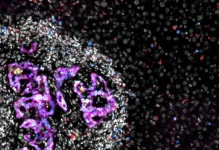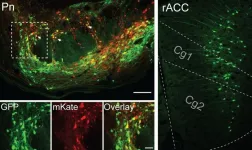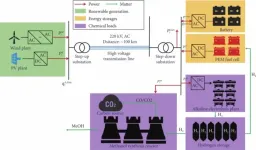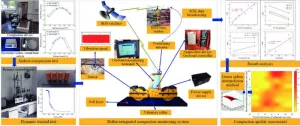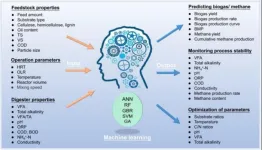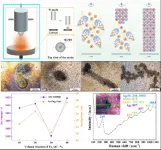(Press-News.org) Cell membranes play a crucial role in maintaining the integrity and functionality of cells. However, the mechanisms by which they perform these roles are not yet fully understood. Scientists from the University of Geneva (UNIGE), in collaboration with the Institut de biologie structurale de Grenoble (IBS) and the University of Fribourg (UNIFR), have used cryo-electron microscopy to observe how lipids and proteins at the plasma membrane interact and react to mechanical stress. This work shows that, depending on conditions, small membrane regions can stabilize various lipids to trigger specific cellular responses. These discoveries, published in the journal Nature, confirm the existence of well-organized lipid domains and begin to reveal the role they play in cell survival.
Cells are surrounded by a membrane - the plasma membrane - which acts as a physical barrier but must also be malleable. These properties are endowed by the constituent components of membranes - lipids and proteins - whose molecular organisation varies according to the external environment. This dynamism is critical to membrane function but must be finely balanced to ensure that the membrane becomes neither too tense nor too floppy. How cells sense changes in the biophysical properties of the plasma membrane is thought to involve microregions on the membrane - known as microdomains - which are postulated to possess a specific lipid and protein content and organization.
High-resolution cryo-electron microscopy
The team led by Robbie Loewith, full professor in the Department of Molecular and Cellular Biology at the UNIGE Faculty of Science, is interested in how the components of the plasma membrane interact with each other to ensure that the overall biophysical properties of the membrane remain optimised for cell growth and survival.
‘‘Until now, the techniques available did not allow us to study lipids in their natural environment inside membranes. Thanks to the Dubochet Center for Imaging (DCI) at the Universities of Geneva, Lausanne, Bern and the EPFL, we have been able to meet this challenge by using cryo-electron microscopy,’’ explains Robbie Loewith. This technique allows samples to be frozen at -200°C to trap membranes in their native state, which can then be observed under an electron microscope.
The scientists used baker’s yeast (Saccharomyces cerevisiae), a model organism used in many research laboratories because it is very easy to grow and genetically manipulate. What’s more, most of its fundamental cellular processes mirror those of higher organisms. This study focused on a specific membrane microdomain scaffolded by a protein coat known as eisosomes. These structures are believed to be capable of sequestering or releasing proteins and lipids to help the cells resist and/or signal damage to the membrane, using processes that were previously unknown.
‘‘For the first time, we have succeeded in purifying and observing eisosomes containing plasma membrane lipids in their native state. This is a real step forward in our understanding of how they function,’’ explains Markku Hakala, a post-doctoral student in the Department of Biochemistry at the UNIGE Faculty of Science and co-author of the study.
Converting a mechanical signal into a chemical signal
Using cryo-electron microscopy, the scientists observed that the lipid organisation of these microdomains is altered in response to mechanical stimuli. ‘‘We discovered that when the eisosome protein lattice is stretched, the complex arrangement of lipids in the microdomains is altered. This reorganisation of the lipids likely enables the release of sequestered signalling molecules to trigger stress adaptation mechanisms. Our study reveals a molecular mechanism by which mechanical stress can be converted to biochemical signaling via protein-lipid interactions in unprecedented detail,’’ enthuses Jennifer Kefauver, post-doctoral researcher in the Department of Molecular and Cellular Biology and first author of the study.
This work opens many new avenues for studying the primordial role of membrane compartmentalisation - i.e. the movement of proteins and lipids within membranes to form sub-compartments known as microdomains. This mechanism enables cells to perform specialised biochemical functions, in particular the activation of cellular communication pathways in response to the various stresses to which they may be exposed.
END
Under pressure: how cells respond to physical stress
UNIGE scientists have discovered how yeast cells sense physical stresses on the membranes that protect them
2024-07-24
ELSE PRESS RELEASES FROM THIS DATE:
Preventing cancer cells from colonizing the liver
2024-07-24
In brief:
ETH Zurich researchers have discovered proteins on the surface of colorectal cancer cells and liver cells that bind together and that play a major role in the formation of new metastases.
The binding of the proteins triggers fundamental changes in colorectal cancer cells that allow them to take root in the liver.
These new findings will help to develop future treatments that may hinder the formation of often fatal metastases.
In cases where cancer is fatal, nine out of ten times the culprit is metastasis. This is when the primary tumour has sent out cells, like seeds, and invaded other organs of the body. While medicine has made great progress in treating primary tumours, ...
Neuroscientists discover brain circuitry of placebo effect for pain relief
2024-07-24
CHAPEL HILL, NC – The placebo effect is very real. This we’ve known for decades, as seen in real-life observations and the best double-blinded randomized clinical trials researchers have devised for many diseases and conditions, especially pain. And yet, how and why the placebo effect occurs has remained a mystery. Now, neuroscientists have discovered a key piece of the placebo effect puzzle.
Publishing in Nature, researchers at the University of North Carolina School of Medicine– with colleagues from Stanford, the Howard Hughes Medical Institute, and ...
'Gene misbehavior' widespread in healthy people
2024-07-24
Scientists have uncovered that ‘gene misbehaviour’ – where genes are active when they were expected to be switched off – is a surprisingly common phenomenon in the healthy human population.
The team also identify several mechanisms behind these gene activity errors. This may help inform precision medicine approaches and enable the development of targeted therapies to correct expression.
Researchers from the Wellcome Sanger Institute, the University of Cambridge and AstraZeneca studied the activity of inactive genes in a large, healthy population for the first time. While rare at the individual gene level, they revealed misexpression ...
Arc Institute welcomes first Scientific Advisory Board members; appoints two new members to Board of Directors
2024-07-24
Today, Arc Institute, the scientific research organization pioneering new models for scientific discovery and translation, is announcing the creation of its Scientific Advisory Board and its first two Scientific Advisors, as well as the appointment of two new members to the Arc Board of Directors.
New Scientific Advisory Board
Dr. Carolyn Bertozzi, Ph.D., and Dr. Aviv Regev, Ph.D., join as the first two members of Arc’s Scientific Advisory Board and will provide strategic guidance, share their ...
NCCN Oncology Research Program celebrates 25 years of advancing cancer science
2024-07-24
PLYMOUTH MEETING, PA [July 24, 2024] — The National Comprehensive Cancer Network® (NCCN®)—an alliance of leading cancer centers—commemorates the 25th anniversary of the NCCN Oncology Research Program (ORP). The NCCN ORP is dedicated to seeking innovative, effective, and equitable cancer care through oversight and funding for cancer research and quality improvement projects. Over the past quarter-century, the NCCN ORP has managed a diverse portfolio of more than 180 research studies and quality improvement projects to improve quality and outcomes for people with cancer. The NCCN ORP has also provided project oversight to 75 NCCN Foundation® Young Investigator Award ...
From grey to green: unveiling the future of renewable e-methanol for cleaner shipping fuels
2024-07-24
Methanol is a crucial chemical feedstock and a potential green fuel, particularly for the shipping industry. Currently, its production predominantly relies on fossil feedstocks, leading to high greenhouse gas emissions. With the global push towards decarbonization, there is an urgent need to explore cleaner alternatives like renewable e-methanol. Based on these challenges, there is a need for in-depth research to develop sustainable methanol production methods.
A team of researchers from Tsinghua ...
A brittle interface with low modulus to improve the mechanical properties of multiphase ceramics: A unique design approach?
2024-07-24
Barium strontium aluminum silicate (BaxSr1−xAl2Si2O8, BSAS) ceramics possess both phase stability and resistance to water vapor corrosion, making them ideal materials for radome technology and electronic packaging. To address the low tolerance of BSAS ceramics to damage and defects, the introduction of nano-reinforcements is an effective approach to enhance their strength and toughness. SiC nanowires (SiCnws) exhibit high strength and hardness inherited from SiC ceramics, along with the excellent toughness and elasticity ...
Intelligent compaction: ensuring highway durability with advanced monitoring
2024-07-24
Highway construction often faces challenges in ensuring long-term subgrade performance due to traditional compaction quality control (QC) methods that rely on manual adjustments and sporadic testing. These methods are susceptible to human error, inefficiency, and incomplete assessments. Addressing these issues requires advanced, real-time monitoring systems. Such systems can provide comprehensive and accurate QC, highlighting the need for innovative technologies to improve highway construction standards.
Researchers from the University of Science and Technology Beijing, alongside partners from Hunan and China Renewable Energy Engineering ...
From trash to treasure: machine learning enhances organic waste recycling
2024-07-24
Biological treatment methods such as anaerobic digestion, composting, and insect farming are essential for managing organic waste, converting it into valuable resources like biogas and organic fertilizers. However, these processes often face challenges due to their inherent complexity and instability, which can affect efficiency and product quality. Traditional control strategies have limited success in addressing these issues. Therefore, advanced methods like machine learning (ML) are being explored to enhance prediction, optimization, and monitoring of these biological treatments, aiming to improve overall performance and sustainability.
A research team from Tongji University ...
g-Ta2AlC, A new electrical contact material
2024-07-24
Relays are extensively utilized in accelerators, satellites, rockets, and various advanced technology sectors. They play crucial roles in signal transmission, long-distance control implementation, and protection circuits, directly impacting the safety of aerospace and defense equipment systems. The selection of electrical contact material in a relay is crucial for its performance. Arc discharge, characterized by high temperature, heat, and energy, is a common occurrence during operation. Consequently, the arc erodes the electric contact material, ...
LAST 30 PRESS RELEASES:
New expert guidance urges caution before surgery for patients with treatment-resistant constipation
Solar hydrogen can now be produced efficiently without the scarce metal platinum
Sleeping in on weekends may help boost teens’ mental health
Study: Teens use cellphones for an hour a day at school
After more than two years of war, Palestinian children are hungry, denied education and “like the living dead”
The untold story of life with Prader-Willi syndrome - according to the siblings who live it
How the parasite that ‘gave up sex’ found more hosts – and why its victory won’t last
When is it time to jump? The boiling frog problem of AI use in physics education
Twitter data reveals partisan divide in understanding why pollen season's getting worse
AI is quick but risky for updating old software
Revolutionizing biosecurity: new multi-omics framework to transform invasive species management
From ancient herb to modern medicine: new review unveils the multi-targeted healing potential of Borago officinalis
Building a global scientific community: Biological Diversity Journal announces dual recruitment of Editorial Board and Youth Editorial Board members
Microbes that break down antibiotics help protect ecosystems under drug pollution
Smart biochar that remembers pollutants offers a new way to clean water and recycle biomass
Rice genes matter more than domestication in shaping plant microbiomes
Ticking time bomb: Some farmers report as many as 70 tick encounters over a 6-month period
Turning garden and crop waste into plastics
Scientists discover ‘platypus galaxies’ in the early universe
Seeing thyroid cancer in a new light: when AI meets label-free imaging in the operating room
Neutrophil-to-lymphocyte ratio may aid risk stratification in depressive disorder
2026 Seismological Society of America Annual Meeting
AI-powered ECG analysis offers promising path for early detection of chronic obstructive pulmonary disease, says Mount Sinai researchers
GIMM uncovers flaws in lab-grown heart cells and paves the way for improved treatments
Cracking the evolutionary code of sleep
Medications could help the aging brain cope with surgery, memory impairment
Back pain linked to worse sleep years later in men over 65, according to study
CDC urges ‘shared decision-making’ on some childhood vaccines; many unclear about what that means
New research finds that an ‘equal treatment’ approach to economic opportunity advertising can backfire
Researchers create shape-shifting, self-navigating microparticles
[Press-News.org] Under pressure: how cells respond to physical stressUNIGE scientists have discovered how yeast cells sense physical stresses on the membranes that protect them
